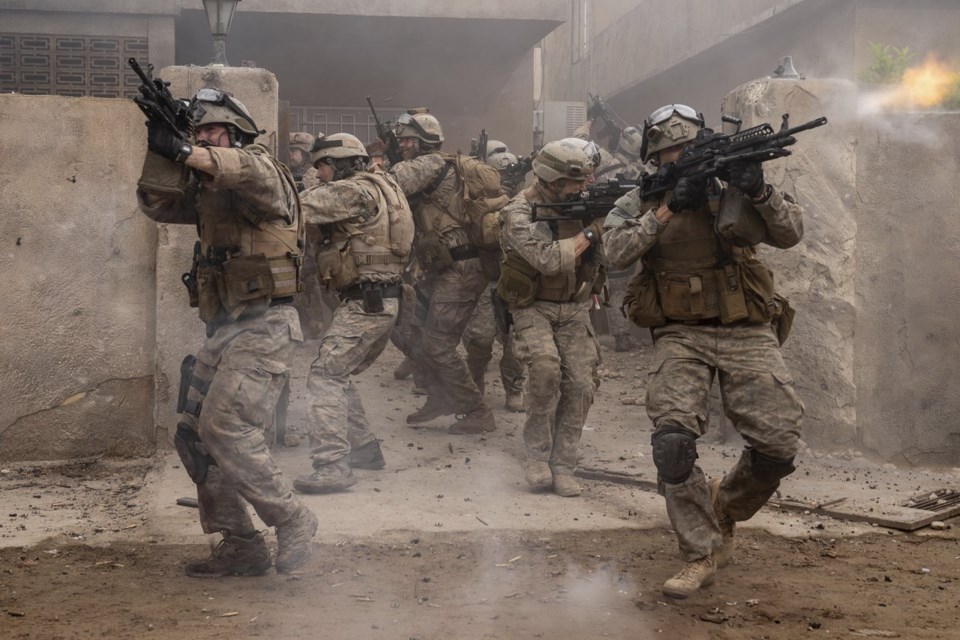Ray Mendoza and ŌĆÖs ŌĆ£WarfareŌĆØ is more defined by what it isn't than what it is.
In their -set film, thereŌĆÖs never any description of a wider strategy. There are no backstories to the American Navy SEALs whom we follow on an unspectacular mission. ThereŌĆÖs not a short monologue about momŌĆÖs cooking back home, let alone a speculative word about life after the war. There's not even a dramatic close-up to be had.
ŌĆ£WarfareŌĆØ aspires to be, simply, just that. We are effectively embedded in a platoon on what seems to be a minor mission in Iraq in 2006. Walking in two single-file lines down a Ramadi street at night, one soldier says, ŌĆ£I like this house.ŌĆØ Under the cover of darkness, they rush inside the apartment building to set up their position while keeping the family inside quiet. In the morning, their sniper, laid out on a raised bed, sweats while looking out on an increasingly anxious scene. His rifleŌĆÖs crosshairs drift through the street scenes outside, as suspected jihadists mobilize around them.
War-movie cliches have been rigorously rooted out of ŌĆ£Warfare,ŌĆØ a terse and chillingly brutal immersion in a moment of the Iraq War. Clouds of IED smoke and cries of agony fill Garland and MendozaŌĆÖs film, with little but the faces of the SEALs to ground a nearly real-time, based-on-a-true-story dramatization. Few words are spoken outside the intense patter of official Navy jargon. When the mission comes to its bloody and hectic conclusion, the only utterance left hanging in the clouded air is the unanswered, blood-curdling shriek of a woman watching the men leave her bombed-out home: ŌĆ£Why?ŌĆØ
A year after a movie predicated on bringing the horror of war home to American soil, Garland has returned with a film even more designed to implode fanciful and far-away ideas of war by bringing it acutely close. Mendoza, an Iraq War veteran who served as a consultant on ŌĆ£Civil War,ŌĆØ co-writes and co-directs ŌĆ£WarfareŌĆØ from his own first-hand experience in Iraq. The movie is introduced as based on the memories of the troops involved, and ŌĆ£WarfareŌĆØ gives little reason to quibble with its ultra verisimilitude.
That doesnŌĆÖt mean Mendoza and GarlandŌĆÖs film isnŌĆÖt without its sympathies. For a movie quaking with sonic tremors, the first thumps sounded in ŌĆ£WarfareŌĆØ come from the 2004 music video to Eric PrydzŌĆÖs ŌĆ£Call on Me,ŌĆØ as the battalion bops in harmony to the female bodies gyrating on a screen in front of them.
In battle, they are hardly any less choreographed. If a mode of American war movie leans toward showing the follies of war on the ground, the soldiers of ŌĆ£WarfareŌĆØ ŌĆö while not immune to a little ŌĆ£Call on MeŌĆØ imitation ŌĆö are supremely precise. When things go haywire here, itŌĆÖs not because the SEALs arenŌĆÖt alert or are haphazard in their regard for the lives around them.
Among them are sniper Elliott (Cosmo Jarvis), Eric (Will Poulter), Tommy (Kit Connor), Sam (Joseph Quinn) and Ray (DŌĆÖPharaoh Woon-A-Tai). We never learn anything about any of them except their fidelity to their comrades and their willingness to do what's necessary when even the heaviest fire is raining down on them.
Sounds of fire pop through the immersive sound design of Glenn Freemantle. Whether ŌĆ£WarfareŌĆØ is the most accurate war film ever made or not, it's certainly among the most sonically enveloping experiences of battle. After an explosion rocks the men, ŌĆ£WarfareŌĆØ staggers in a concussed haze. The film's craft, generally, is impressive, including production designer Mark Digby's recreation of the Ramadi block.
Despite all the effort to shed ŌĆ£WarfareŌĆØ of war-movie tropes, though, they do intrude in one glaring way. Like countless movies before it, ŌĆ£WarfareŌĆØ runs its credits alongside photographs of the real SEALs (some faces are blurred out), along with footage of them with the actors and filmmakers on set. To honor the real men is, of course, laudable and necessary. But the behind-the-scenes tone of the epilogue chafes with the spell cast by ŌĆ£Warfare.ŌĆØ
The point of ŌĆ£Warfare,ŌĆØ to me, seems less about paying these Navy SEALs tribute than showing combat how it truly unspools ŌĆö messily, chaotically and pointlessly. With the exception of a pair of Iraqi interpreters, ŌĆ£WarfareŌĆØ ŌĆö despite its broad title ŌĆö limits itself to one side of a battle. But I'd argue the only bad guy in ŌĆ£WarfareŌĆØ isn't on either side of the fight, but is found in the aerial viewpoint ŌĆö used sporadically by the filmmakers ŌĆö from a U.S. plane overhead that renders every person mere pixels on a screen.
In this forensic portrait of war, the only way to not get what's happening on the ground is to be too far from it. Fran├¦ois Truffaut famously said thereŌĆÖs no such thing as an anti-war film because movies inherently glamorize war. ŌĆ£Warfare,ŌĆØ though, is intent on challenging that old adage.
ŌĆ£Warfare,ŌĆØ an A24 release is rated R by the Motion Picture Association for intense war violence and bloody/grisly images, and language throughout. Running time: 107 minutes. Three stars out of four.
Jake Coyle, The Associated Press




